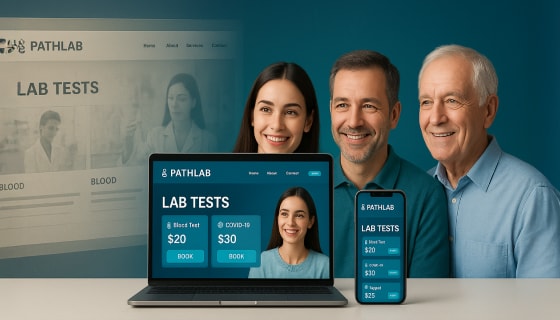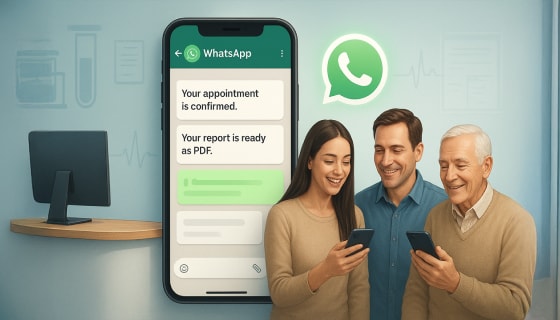Every business today has a marketing budget to reach potential clients, and orthopedic surgeons are no exception. Gone are the days when patients solely relied on pamphlets, billboards, or word of mouth. Today, most patients are more likely to engage with ads on their phones rather than notice an out-of-home (OOH) ad.
So, why not meet them where they are—online? Google Ads offers orthopedic surgeons the opportunity to connect directly with patients who are actively searching for joint replacement solutions, right when they need them most. It’s a cost-effective and powerful way to cut through the noise and bring your services directly to the patient’s phone screen.
In this blog, we’ll walk you through how to set up and optimize your Google Ads for orthopedic surgeons, which can drive more consultations and grow your practice. Whether you’re just starting with ads or looking to refine your strategy, you’ll find actionable insights to make your campaigns more successful and cost-efficient.
Setting Up Your Google Ads Account for Success
Traditional marketing methods, such as billboards and pamphlets, are no longer enough. As patients increasingly turn to their smartphones to search for healthcare providers, your clinic must show up when they search. Google Ads allows you to target patients actively searching for joint replacement services, right at the moment they need help.
Here’s how to set up your Google Ads account and run a successful campaign that can drive more consultations and grow your practice:
Create Your Google Ads Account
Getting started with Google Ads is a straightforward process. To create your account:
- Go to Google Ads and sign in with your Google account (or create one). Once logged in, click “Start Now” and follow the prompts to enter your clinic’s details, such as your name, website, location, and billing information.
- For better performance tracking, connect your Google Ads account to Google Analytics. This enables you to track the patient journey from ad click to appointment booking, allowing you to optimize your strategy over time.
Choose Your Campaign Type
Search Ads are the go-to choice for orthopedic surgeons. These ads appear when patients search for keywords like “hip replacement surgeon” or “knee replacement near me.” You can choose between “Leads” or “Website Traffic” as your campaign goal, depending on whether you’re trying to book consultations directly or just drive more traffic to your website.
On the other hand, Display Ads are more suited for brand awareness and won’t target users who are actively seeking surgery.
Set Up Conversion Tracking
Conversion tracking is essential to measure the effectiveness of your ads. You need to know how many of those clicks are turning into real patients walking through your doors.
To set it up:
- In Google Ads, go to Tools & Settings > Measurement > Conversions.
- Select the type of conversion you want to track, such as phone calls, form submissions, or appointment bookings.
- Google will give you a tracking code. Add this to your website’s confirmation page (e.g., the page users see after submitting a form or booking an appointment).
Target the Right Keywords
Selecting the right keywords is crucial to ensuring your ads appear when patients are searching for your services.
How to Choose the Best Keywords:
- Use Google’s Keyword Planner to find high-traffic, relevant keywords like “best knee replacement surgeon.” Long-tail keywords, such as “top-rated hip surgeon in [City],” are more specific and tend to attract patients with stronger intent.
- Exclude irrelevant searches with negative keywords. For example, phrases like “cheap surgery” or “free consultation” may not align with your clinic’s offerings and could waste your ad budget.
- Focus on specific phrases that show high intent, such as “affordable knee replacement in [City].” These are more likely to convert into actual consultations.
Use Ad Extensions for Local Targeting
Ad Extensions provide extra information, making your ad more appealing to users and helping it stand out in search results. These are crucial for targeting local patients and providing them with additional means of contact.
Types of Extensions to Use:
- Location Extensions: Show your clinic’s address in the ad, making it easier for local patients to find you.
- Call Extensions: Allow users to call your clinic directly by clicking on the ad. This is crucial when patients require immediate assistance.
- Sitelink Extensions: Enable you to add links to specific pages on your site, such as “Book an Appointment” or “Meet Our Surgeons,” directly guiding potential patients to the information they need.
In addition to these, Google Ads offers several other extensions, such as Structured Snippet Extensions, Promotion Extensions, Affiliate Location Extensions, and App Extensions, that can further enhance your ads.
Set Your Budget and Bidding Strategy
Setting a budget and choosing a bidding strategy is critical for managing your ad spend and ensuring you get the most out of your campaigns.
- Start with a reasonable daily budget (around $20-$50 per day) and adjust based on campaign performance.
- If you’re new to Google Ads, start with the Maximize Clicks strategy. Google will automatically adjust your bids to maximize clicks within your budget.
- Once you’ve gathered data and optimized your campaigns, switch to Target CPA to focus on driving conversions (e.g., consultations). This strategy aims to maximize conversions at a cost that fits within your budget.
Monitor and Optimize Your Campaign
Once your ads are live, you’ll want to monitor their performance and make adjustments as needed.
- Review key metrics like Click-Through Rate (CTR), Conversion Rate, and Cost Per Conversion. These will help you understand how well your ads are performing.
- Run A/B tests with different ad copy, CTAs, and keywords to see what works best for your audience.
- Google Ads provides AI-powered insights that suggest adjustments to improve your campaign’s performance. Pay attention to these recommendations to fine-tune your approach.
Let’s now explore how Smart Bidding and AI optimization in Google Ads can help you drive better results with less manual effort.
Smart Bidding and AI Optimization in Google Ads
Google’s AI-driven bidding helps reduce wasted ad spend by automatically adjusting your bids based on real-time data using machine learning. AI in Google Ads works by analyzing vast amounts of data to predict the likelihood of a click leading to a conversion and optimizes budget allocation to focus on high-conversion opportunities.
Two popular strategies designed to maximize the effectiveness of your campaigns are:
Target CPA (Cost Per Acquisition) bidding strategy focuses on achieving a specific cost per conversion. For example, if you want to keep your cost for each appointment booking under $50, Target CPA will automatically adjust your bids to help you achieve that goal. It’s ideal for orthopedic clinics seeking to manage their costs while driving patient acquisition efficiently.
The Target ROAS (Return on Ad Spend) strategy focuses on maximizing revenue rather than just conversions. Google adjusts bids to maximize your return on ad spend based on your predefined target. If your clinic’s goal is to generate $5 in revenue for every $1 spent on ads, Target ROAS ensures that your budget is optimized to meet that target.
While AI optimization can significantly enhance campaign performance, it’s still crucial to regularly monitor and fine-tune your campaigns to ensure optimal effectiveness. Here are some top tips:
- Tip 1: Set clear campaign objectives. Google’s AI optimizes better when it has specific goals.
- Tip 2: Monitor CTR, Conversion Rate, and Cost Per Conversion to gauge ad effectiveness.
- Tip 3: Regularly check Google’s AI insights and apply optimization recommendations.
- Tip 4: Test Target CPA and ROAS to maximize revenue. Adjust based on results.
- Tip 5: Pause underperforming keywords and experiment with new ones to improve relevance.
- Tip 5: Utilize A/B tests to compare different ad copies, landing pages, and CTAs and identify the most effective elements.
- Tip 6: Ensure your landing pages are mobile-friendly for a smooth user experience.
Now that your campaign is set up for success, it’s time to focus on creating ads that truly grab attention.
Creating Effective Ads: Simple Hacks
When creating Google Ads for orthopedic clinics, it’s crucial to craft ad copy that resonates with your patients’ real-life struggles. Patients searching for joint replacement services are often dealing with pain, restricted mobility, and the fear of a long, difficult recovery. Your ad copy should acknowledge these concerns and offer a solution. For instance, instead of just saying, “We offer knee replacement surgery,” try something more empathetic like:
- “Get back to enjoying life with pain-free movement.”
- “Fast recovery, so you can get back to doing what you love.”
- “Pain relief and mobility restoration—book your consultation today.”
These examples highlight key pain points, such as recovery time, pain relief, and improved mobility, which are top concerns for patients. Additionally, using words that resonate with your patients’ emotions is one of the most effective ways to engage them. For example, instead of using medical jargon like “orthopedic procedure,” try phrases like:
- “Feel like yourself again.”
- “Live without the constant pain.”
- “Your journey to pain relief starts here.”
Creating compelling ads is a great start, but it doesn’t stop there. You need to A/B test your ad copy and landing pages regularly to understand what truly resonates with your audience.
By tracking which version performs better, you can refine your ad copy and create more engaging, conversion-driven ads. Images are just as important as words in creating a compelling ad. Choose images of real patients or healthcare professionals that convey trust, empathy, and the human side of healthcare. For instance, a picture of a smiling patient after their successful recovery will have a far greater impact than an impersonal image of a surgical instrument. Similarly, showing an orthopedic surgeon consulting with a patient makes your practice appear more welcoming and trustworthy.
The goal is to build trust and resonate with your patients on a personal level, making them feel that your clinic is the right choice for their joint replacement needs.
How to Use AI-Powered Tools to Analyze Ad Performance
To ensure your Google Ads campaigns are driving real results, it’s crucial to track key metrics. These metrics help you understand if your ads are engaging the right patients and converting clicks into consultations. Google Analytics makes this tracking even easier, allowing you to see how users behave on your site after clicking your ad. This data is invaluable for refining your landing pages and improving conversion rates.
One of the standout features of Google Ads is its AI-powered tools. These tools automatically optimize your bids, targeting, and budget based on real-time performance, so you don’t need to adjust anything manually. Beyond simply adjusting bids, AI provides valuable insights and suggestions that enable you to improve your campaigns for better results continually.
To dive deeper into these metrics and learn how web analytics can help track and optimize your digital marketing strategy, check out our latest blog on How Web Analytics Can Supercharge Your Digital Marketing Strategy.
Now, let’s take a look at the final, often overlooked aspect of Google Ads
Ad Scheduling and Targeting Best Practices
Effective ad scheduling ensures your Google Ads campaigns reach potential patients at the most opportune times. Research indicates that ads run from 6 PM to 12 AM yield the highest conversion rates, followed by those run from 6 AM to 1 PM. Conversely, weekends, especially Saturdays, tend to have lower conversion rates.
For orthopedic clinics, it’s essential to align ad schedules with patient behavior. Many individuals search for joint replacement services during evenings or weekends when they have more time to research. Therefore, adjusting your ad schedule to target these peak times can enhance visibility and engagement.
Additionally, geotargeting plays a crucial role in healthcare marketing. Patients often prefer healthcare providers who are located near them. By focusing your ads on specific locations, such as cities, zip codes, or a defined radius around your clinic, you can attract local patients more effectively. This strategy not only improves ad relevance but also increases the likelihood of in-person consultations.
Now, it’s time to wrap this up.
Conclusion
Meta Ads have become one of the most effective tools for businesses looking to connect with their audience. With more than 2.8 billion active users across Facebook and Instagram, Meta platforms provide highly targeted ad solutions that allow you to reach the right customers at the right time.
At ZealousWeb, we specialize in creating data-driven ad campaigns that maximize visibility and drive results. Our expertise spans social media marketing, local SEO, and more, ensuring your business stands out to potential customers. We’re offering a 30-minute free strategy call—don’t miss this opportunity to boost your business! Pick up the phone and get in touch with us today.













